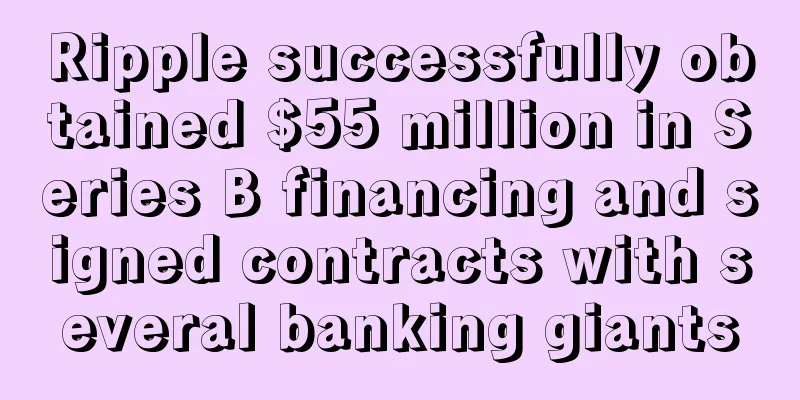Ripple successfully obtained $55 million in Series B financing and signed contracts with several banking giants

|
On the evening of September 15th, Beijing time, distributed ledger settlement startup Ripple announced the completion of a US$55 million Series B financing round. The lead investors include Standard Chartered Bank, Accenture Ventures, Standard Chartered Digital Ventures, Siam Commercial Bank and the venture capital department of SBI Holdings. Other investors include Santander InnoVentures, CME Venture, Seagate Technology and Venture 51. Ripple President and COO Brad Garlinghouse told reporters:
As of now, Ripple has received a total of Ripple was founded in 2012, at a time when most startups in the industry were focused on the Bitcoin protocol. However, Ripple (then called OpenCoin) chose to take a different path. Unlike Bitcoin, Ripple's consensus ledger requires permission, which means that banks do not have to worry about anonymous entities verifying transactions. In addition, Ripple's distributed ledger products and services do not require its native token XRP (Ripple coin). Success did not happen overnight. It took Ripple nearly a year to win its first customer (German Internet bank Fidor). Four months later, the company signed two US banks, and six months later, more than a dozen banks reached deals with Ripple. But Garlinghouse said the raft of new clients announced today was largely due to last year's Sibos banking conference. “It’s one of our biggest expenses,” he said, “but it’s also the one that gives us the best return on investment.” Growing number of banking partnersIn addition to today’s funding news, Ripple also announced that a number of major banks will officially join its network, including: Standard Chartered Bank, Westpac Banking Corporation, National Australia Bank (NAB), Mizuho Financial Group (MHFG), BMO Financial Group, Siam Commercial Bank and Shanghai Huarui Bank. According to the company, while various financial institutions have successfully transferred actual funds to the Ripple network, the banks are currently building their own commercial products. As an example, Garlinghouse said that Chinese private bank Shanghai Huarui is working with Ripple to build a new commercial cross-border payments service, which aims to allow the bank’s customer base to make international remittances in real time. Overall, the Ripple network now includes The company's scale has grown explosivelyAccording to Garlinghouse, Ripple is scaling faster as these new banks sign on. Currently, the company has about 150 employees and is recruiting another 25 people. More than 50% of Ripple's hires in the past quarter were engineers, and Garlinghouse estimates that the company's compliance department has more members than any of its competitors. "Banks need that support," he said. It is reported that Ripple will move out of its headquarters in San Francisco within the next six months, and the new headquarters will be twice the size of the current headquarters. |
<<: Prepare for a rainy day and get ready for Bitcoin hard fork. All you need is a good reason
Recommend
The karma of good and evil in face reading
The karma of good and evil in face reading Good d...
Is the fate of an unclosed phoenix eye pattern good? What should I do if my fate is bad?
In palmistry, there is a type of palm print called...
Three Bitcoin platforms suspend withdrawals due to anti-money laundering system upgrade
Beijing Business Daily (Reporter Yue Pinyu) On Ma...
Why does acne on the nose cause financial loss?
It is not uncommon to have pimples on the nose. M...
The Supreme People's Court and the National Development and Reform Commission: Strengthen the protection of new rights and interests such as digital currency and online virtual property
On July 22, the Supreme People's Court and th...
Jiyuan Fortune Telling: Will Wu Zongxian encounter financial problems due to tax arrears?
According to Taiwanese media reports, the tax fil...
False Broken Palmistry Analysis
The so-called broken palm refers to the combinati...
Whales sell off ETH in large quantities, earning millions
Source: LongHash Data from crypto market research...
Five palm lines for achieving great things
Success certainly makes people happy, but failure...
27 Crypto Predictions for 2024
1. The battle for data availability will begin an...
Analysis of the size of a woman's eyes
As one of the traditional physiognomy techniques, ...
People with moles on the upper ear are easily deceived and easily trust villains.
People with moles on the upper earlobes do not ha...
Physiognomy reveals the secrets of how to read the face of a man who will bring bad luck to his wife
Some people say that women with high cheekbones w...
Bitcoin is going crazy! It’s not because of the US election, but because of the Chinese
According to Yahoo Finance, the price of Bitcoin ...
Bitcoin mining needs to consider four major issues: electricity and equipment costs are the biggest
Bitcoin mining has become a competitive industry ...









